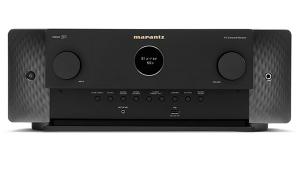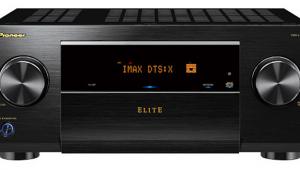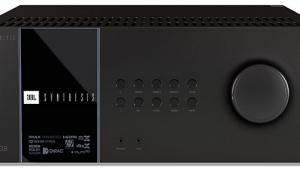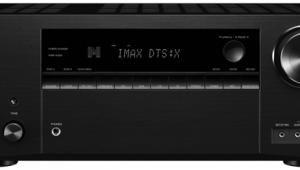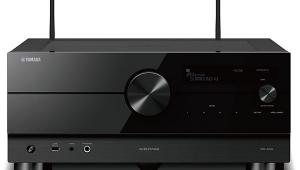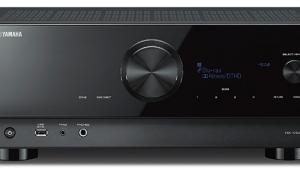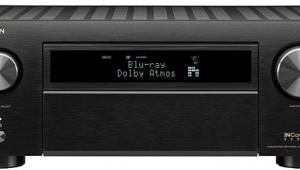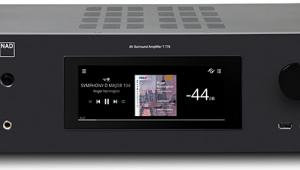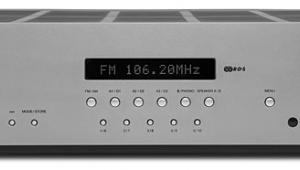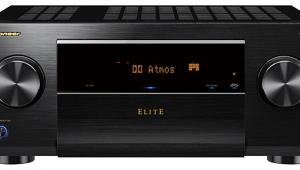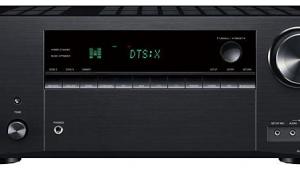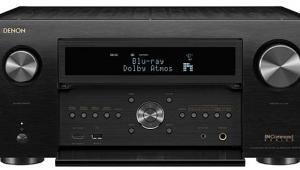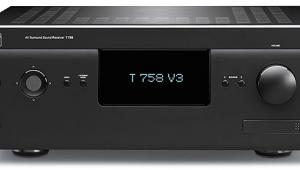Pioneer Elite SC-68 A/V Receiver Page 2
 Better Sound From Computers
Better Sound From Computers
Stop the presses and the servers: The SC-68 is the world’s first receiver with an asynchronous DAC (digital-to-analog converter) capable of supporting direct USB input from a computer. Of course, receivers have sported sophisticated silicon—in this case, a pair of Texas Instruments Aureus chips with resolution of 32 bits and sampling rate of 192 kHz—for a long time to support surround codecs, bass management, room correction, and myriad other functions. But thanks to advances in digital audio processor technology and the availability of high-resolution downloads, the keen-eared listener has a new incentive to get the receiver on speaking terms with a PC or Mac. Pioneer rises to the moment by devoting a back-panel USB-DAC input to the job. Just spin the front-panel input select knob, and there it is. The computer must have a USB 2.0 bus, though this version has appeared in computers from 2000 onward so there’s a good chance yours has this. To obtain resolution above 24/48, install the exclusive driver from the supplied CD-R.
Now, computers tend to make lousy audio sources. They’re often so unsuitable for playback of high-resolution content that they practically negate the purpose of buying it. Besides being cumbersome objects, they tend to multitask, resulting in jitter— with audible timing errors in the bitstream. The receiver’s asynchronous DAC wrestles the clocking function away from the PC and cleans up the sound considerably. Even plain ol’ MP3s benefit—but what’s especially gratifying is that you can now use the computer to download lossless FLAC or uncompressed WAV files, play them on the computer itself, and hear the benefit of their higher resolution on your primary theater speakers. The DAC offers the option of requantizing 16-, 20-, and 24-bit material to 32 bits to achieve what the manual calls “smoother, more subtle musical expression.” Its digital filter can be set as follows: “slow (soft and warm), sharp (solid and tight), and short (quick and forward).” You can easily toggle these two functions on or off via remote buttons. All my demos used 32-bit requantization and the slow mode, Pioneer’s default settings.
Incidentally, Pioneer also offers a proprietary PQLS jitter reduction circuit for an HDMI-connected Pioneer Blu-ray player. It applies to both stereo and surround signals, and once again, a button on the remote lets you A/B it.
Via USB, the receiver supports FLAC, WAV, MP3, WMA, and various iPod formats. Via network, the list also includes LPCM. FLAC and WAV are both supported at 192 kHz. The front USB jack accepts direct dockless plug-in of all but the oldest iPads, iPhones, and iPods. Interestingly, in another industry first for AVRs, the USB jack also accepts the
DSD DFF files that give the Super Audio CD its high resolution. Legal DFF downloads are available from a few small music labels such as Blue Coast, Channel Classics, and 2L. It’s also possible to rip SACDs to DFF, FLAC, or WAV if you have the appropriate third-party software.
Associated equipment included five Paradigm Reference Studio 20 v.4 speakers, a Paradigm Seismic 110 sub, Oppo BDP-83 universal disc player, Micro Seiki BL-51 turntable, Shure M97xE phono cartridge, and Onix OA 21s integrated amp serving as phono preamp. The primary PC was a Lenovo ThinkPad Edge 14 Win7 laptop with 4 GB of RAM and a 320-GB 7,200-rpm hard drive. Music player software included Foobar 2000 (freeware) for high-resolution files and Windows Media Player for others. All movie demos were on Bluray Disc.
Statuesque
You’re probably wondering how this D3 receiver differs from Pioneer’s Class AB models, including the Elite VSX-53 that recently joined my reference system. It does sound different and, in many respects that matter, better. In a nutshell: The top end has marginally less air, but the middle and bottom frequencies are much better defined and more dynamically assured, with stronger weight and superior structure. If these receivers were statues, the D3 model would have more muscle over a more substantial skeleton but just a little less refinement in the bone structure of the face; while the Class AB model would have more soulful and communicative facial features but less muscle definition and bone density below the neck. Weighted in terms of importance on a scale of 1 to 10, the top-end characteristic is a 2, while the mid- and lower-frequency characteristics are together an 8. In other words, the mid/low beneaththe-neck stuff makes a bigger difference and to me is well worth the trade-off. As a practical matter, if you like dynamically wide movie soundtracks and rock ’n’ roll, D3 is for you. But it is not a one-trick pony: It is balanced enough to do everything at a high level of competence.
Super 8 is a darker and more turbulent rewrite of E.T. with Steven Spielberg participating as producer and J.J. Abrams scripting and directing. Starting with a prolonged train wreck, it’s loaded with serious mayhem and dramatic dynamic challenges. The more I listened to this relentless barrage, the more the receiver impressed me. Not only did it play apocalyptically yet palatably loud—it played loud in a wide range of ways, revealing a surprising wealth of dynamic gradations. These gradations were integrated into a discernible dynamic flow, like dots on a line, and the receiver maintained iron control of this dynamic arc to an unusual degree. It also made me forget where the speakers were sitting, as though it had waved a magic wand and bidden them to disappear, replacing them with a large and well-integrated soundfield.
Once in a while, the receiver’s top end bordered on antiseptic. In Gone, with Amanda Seyfried hunting (and being hunted by) a serial killer, strings were bland and elusive. Yet I had little else to complain of: Dialogue, bass control, and other performance parameters were spot on. And the dynamic flow that had wowed me in the previous demo remained. About halfway in, I chastised myself for being too analytical, listening too hard, and then let the movie carry me away.
Intruders is a psychological thriller with Clive Owen stalking (and being stalked by) a malevolent supernatural presence. Here there was more activity in the upper mids and highs, and the receiver responded accordingly. The strings had more of an edge, though they lacked the nth degree of refinement. The soundfield was smaller, but more specific, than in the previous two demos.
Vinyl and Beyond
My relationship with the SC-68 was still in the getting-to-know-you phase when I played an old cutout LP of Bryan Ferry’s underrated masterpiece The Bride Stripped Bare—originals and covers recorded when he was feeling raw, Jerry Hall just having dumped him for Mick Jagger—but the results were too good to omit. The rhythm section grabbed me. It was fully developed and lacked nothing, giving the monster groove of “Take Me to the River” an irresistible flow (that word again). This vindicated the MCACC-sculpted bass management as much as the amp’s inherent strength. I toggled MCACC to make sure of it. Waddy Wachtel’s electric guitars, which make the album so bravely un-Roxy, had as much snap and crackle as my phono cartridge would allow.
Most of the formal music listening demos focused on the USB DAC. Some of these demos were marred by glitching, especially with 192-kHz material. This turned out to be partly a buffering problem: Increasing the buffer size in Foobar 2000 helped. But to eliminate it entirely, I had to install a virgin USB cable with a ferrite-core noise suppressor.
The HDtracks releases of Blue Note classics in 24/192 include some of the most mind-blowing high-resolution content that’s come my way. In Horace Silver’s Song for My Father, the high-resolution DAC and content maximized the texture and solidity of every instrument. Saxes and horns maintained their velvety feel even as they pushed at the outer edges of the dynamic envelope. Silver’s Hammond was mellifluous yet solid. Drums and bass were leaner and tighter in MCACC mode, but fuller and stronger in Pure Direct, and I came to prefer the latter.
The USB DAC and D3 amps could be a jaw-droppingly powerful combination. In the first seconds of Larry Young’s Unity, the drums—though limited to the right speaker—practically floored me, punching through with powerful bass weight and crisp transient response, both meaty and snappy. Donning AKG K240 headphones for a few minutes, I found that the Pioneer makes a fine headphone amp, with good imaging and sometimes surprising depth perception: I could perceive the distance of cymbals from the mike, but they lost little of their authentic metallic sheen. All of this was a tribute to Rudy Van Gelder’s original engineering jobs, his transfers of his own tapes to an ultra-high-resolution medium, and what I now recognized as the receiver’s dynamic and tonal virtuosity. Kudos to HDtracks for doing high resolution right. Kudos to Pioneer for letting me hear the difference.
Among a half-dozen orchestral selections, the standout was Bruckner’s Fourth Symphony with Bernard Haitink conducting the London Symphony Orchestra (24/48, B&W Society of Sound). The receiver’s wide dynamic capability was tailor-made for Bruckner’s massive architecture and surging waves. I could play it pretty loud with minimal fatigue—though the room-corrected presentation was thinner, harder, and less palatable than the Pure Direct presentation, without room correction, Phase Control, or bass management. The lack of bass management was never a deal breaker thanks to the receiver’s potent bass response. It gave the Paradigms’ 7-inch aluminum woofers a good kick.
When not luxuriating in high resolution, I used a few other forms of network connectivity for background listening. AirPlay required me to enable Network Standby in the receiver GUI, then select the SC-68 as a playback source on my iPod touch. DLNA functioned with two different router-connected computers using both wired and wireless connections—the latter was a first for me. The SC-68 detected my WinXP desktop PC via Ethernet, and once I OK’d the receiver as a media-sharing device at the PC end, the receiver could pull music off the PC’s hard drive. The receiver also detected a Win7 laptop linked to the router via Wi-Fi. This time the process was automatic—I didn’t have to OK media sharing in Win7. It just worked. In either case, the lower-quality lossy portions of my music library sounded as good as they could within their inherent limitations.
While I didn’t spend a lot of time making direct Class D versus Class AB comparisons between the SC-68 in the guest-receiver berth and the Pioneer Elite VSX-53 in the reference-receiver berth, I did play the entirety of Keith Jarrett’s Solo Concerts (LP) on the SC-68, a few weeks after playing it on the VSX-53. At first the SC-68 seemed to have both firmer bass and a cruder top end. But as I cruised to the Bremen concert encore, halfway through the set, some things had happened: The SC-68 and phono preamp warmed up and the top-end distinction diminished. By the time the Lausanne concert was under way—different recording, different hall, possibly different piano—the topend distinction diminished further, almost to the vanishing point, leaving the SC-68’s firmer bass as the one distinction of which I was absolutely certain. I could have spent weeks and weeks pursuing this.
If I were to live with the SC-68—and I could easily do so—I’d use MCACC and all the trimmings for the studio-constructed soundscapes of movies and rock, but my default mode for classical and jazz would be Pure Direct, which is more of a viable choice with great-sounding amplification. Which this receiver has. And I’m willing to underscore the point. With sentence fragments. To make sure you notice.
The Pioneer Elite SC-68 is not only a great audio/video receiver but a milestone in the growth of the product category. It’s the first AVR to include a highquality USB DAC and would be memorable for that alone. If you want to listen to high-resolution audio files through a receiver as they’re meant to be heard without a fancy standalone DAC, this is the only game in town. The D3 amplification is dynamically compelling and well rounded in other performance parameters. If you approach it without preconceptions, it’ll treat you right.
This receiver is not for everyone: More than most, Pioneer tends to favor the advanced user over the newbie, opting for versatility over simplicity whenever faced with the choice. But surround sophisticates will love toggling the receiver’s room correction, Phase Control, DAC controls, and other modes for the vast array of content that this receiver can support through its numerous wired and wireless connectivity options. If AVRs were people, this one would be part Muhammad Ali, part Albert Einstein.
